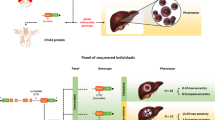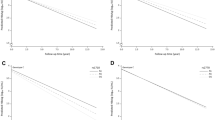Abstract
IL28B polymorphisms strongly predict spontaneous and treatment-induced clearance of hepatitis C virus (HCV) infection. A recent study proposed a 32-base pair deletion in the CC-chemokine receptor 5 (CCR5) gene (CCR5-Δ32) interacting with the IL28B polymorphisms to influence spontaneous HCV clearance. The aim of this study was to clarify the role of CCR5-Δ32 in treatment-induced clearance of chronic hepatitis C (CHC). A cross-sectional cohort of 813 Caucasian patients with CHC genotype 1 (365 responders and 448 non-responders) who had received standard of care dual therapy with interferon (IFN)-α and ribavirin (RBV) was genotyped for the CCR5-Δ32 and IL28B polymorphisms to examine their interaction with respect to treatment response. CCR5-Δ32 did not influence treatment-induced recovery to IFN-α/RBV in CHC, and did not improve prediction of sustained virological response in the context of the IL28B polymorphisms in a multivariate model. CCR5-Δ32 homozygotes were significantly more frequent in those with CHC than healthy controls in the European cohorts (2.9% vs 0.4%, P<0.0001), but not in Australians of European ancestry. In conclusion, CCR5-Δ32 does not influence treatment response in the context of IL28B polymorphisms. Although CCR5-Δ32 may affect viral clearance within closely controlled geographical and genetic environments, we found no effect in larger cohorts treated with dual therapy.
This is a preview of subscription content, access via your institution
Access options
Subscribe to this journal
Receive 6 digital issues and online access to articles
$119.00 per year
only $19.83 per issue
Buy this article
- Purchase on Springer Link
- Instant access to full article PDF
Prices may be subject to local taxes which are calculated during checkout

Similar content being viewed by others
References
WHOHepatitis C. Fact Sheet No. 164. Revised October 2000. http://www.who.int/mediacentre/factsheets/fs164/en/.
Hoofnagle JH . Course and outcome of hepatitis C. Hepatology 2002; 36: S21–S29.
Lambotin M, Raghuraman S, Stoll-Keller F, Baumert TF, Barth H . A look behind closed doors: interaction of persistent viruses with dendritic cells. Nat Rev Microbiol 2010; 8: 350–360.
Shields PL, Morland CM, Salmon M, Qin S, Hubscher SG, Adams DH . Chemokine and chemokine receptor interactions provide a mechanism for selective T cell recruitment to specific liver compartments within hepatitis C-infected liver. J Immunol 1999; 163: 6236–6243.
Soo HM, Garzino-Demo A, Hong W, Tan YH, Tan YJ, Goh PY et al. Expression of a full-length hepatitis C virus cDNA up-regulates the expression of CC chemokines MCP-1 and RANTES. Virology 2002; 303: 253–277.
Nattermann J, Nischalke HD, Feldmann G, Ahlenstiel G, Sauerbruch T, Spengler U . Binding of HCV E2 to CD81 induces RANTES secretion and internalization of CC chemokine receptor 5. J Viral Hepat 2004; 11: 519–526.
Lichterfeld M, Leifeld L, Nischalke HD, Rockstroh JK, Hess L, Sauerbruch T et al. Reduced CC chemokine receptor (CCR) 1 and CCR5 surface expression on peripheral blood T lymphocytes from patients with chronic hepatitis C infection. J Infect Dis 2002; 185: 1803–1807.
Deng H, Liu R, Ellmeier W, Choe S, Unutmaz D, Burkhart M et al. Identification of a major co-receptor for primary isolates of HIV-1. Nature 1996; 381: 661–666.
Samson M, Libert F, Doranz BJ, Rucker J, Liesnard C, Farber CM et al. Resistance to HIV-1 infection in caucasian individuals bearing mutant alleles of the CCR-5 chemokine receptor gene. Nature 1996; 382: 722–725.
Dean M, Carrington M, Winkler C, Huttley GA, Smith MW, Allikmets R et al. Genetic restriction of HIV-1 infection and progression to AIDS by a deletion allele of the CKR5 structural gene. Hemophilia Growth and Development Study, Multicenter AIDS Cohort Study, Multicenter Hemophilia Cohort Study, San Francisco City Cohort, ALIVE Study. Science 1996; 273: 1856–1862.
Stewart G . Chemokine genes--beating the odds. Nat Med 1998; 4: 275–257.
Woitas RP, Ahlenstiel G, Iwan A, Rockstroh JK, Brackmann HH, Kupfer B et al. Frequency of the HIV-protective CC chemokine receptor 5-Delta32/Delta32 genotype is increased in hepatitis C. Gastroenterology 2002; 122: 1721–1728.
Goulding C, McManus R, Murphy A, MacDonald G, Barrett S, Crowe J et al. The CCR5-delta32 mutation: impact on disease outcome in individuals with hepatitis C infection from a single source. Gut 2005; 54: 1157–1161.
Nattermann J, Timm J, Nischalke HD, Olbrich A, Michalk M, Tillmann HL et al. The predictive value of IL28B gene polymorphism for spontaneous clearance in a single source outbreak cohort is limited in patients carrying the CCR5Delta32 mutation. J Hepatol 2011; 55: 1201–1206.
Thomas DL, Thio CL, Martin MP, Qi Y, Ge D, O'Huigin C et al. Genetic variation in IL28B and spontaneous clearance of hepatitis C virus. Nature 2009; 461: 798–801.
Suppiah V, Gaudieri S, Armstrong NJ, O'Connor KS, Berg T, Weltman M et al. IL28B, HLA-C, and KIR variants additively predict response to therapy in chronic hepatitis C virus infection in a European cohort: a cross-sectional study. PLoS Med 2011; 8: e1001092.
Ge D, Fellay J, Thompson AJ, Simon JS, Shianna KV, Urban TJ et al. Genetic variation in IL28B predicts hepatitis C treatment-induced viral clearance. Nature 2009; 461: 399–401.
Suppiah V, Moldovan M, Ahlenstiel G, Berg T, Weltman M, Abate ML et al. IL28B is associated with response to chronic hepatitis C interferon-alpha and ribavirin therapy. Nat Genet 2009; 41: 1100–1104.
Tanaka Y, Nishida N, Sugiyama M, Kurosaki M, Matsuura K, Sakamoto N et al. Genome-wide association of IL28B with response to pegylated interferon-alpha and ribavirin therapy for chronic hepatitis C. Nat Genet 2009; 41: 1105–1109.
Rauch A, Kutalik Z, Descombes P, Cai T, Di Iulio J, Mueller T et al. Genetic variation in IL28B is associated with chronic hepatitis C and treatment failure: a genome-wide association study. Gastroenterology 2010; 138: 1338–1345.
Ahlenstiel G, Berg T, Woitas RP, Grunhage F, Iwan A, Hess L et al. Effects of the CCR5-Delta32 mutation on antiviral treatment in chronic hepatitis C. J Hepatol 2003; 39: 245–252.
Promrat K, McDermott DH, Gonzalez CM, Kleiner DE, Koziol DE, Lessie M et al. Associations of chemokine system polymorphisms with clinical outcomes and treatment responses of chronic hepatitis C. Gastroenterology 2003; 124: 352–360.
Hellier S, Frodsham AJ, Hennig BJ, Klenerman P, Knapp S, Ramaley P et al. Association of genetic variants of the chemokine receptor CCR5 and its ligands, RANTES and MCP-2, with outcome of HCV infection. Hepatology 2003; 38: 1468–1476.
Mascheretti S, Hinrichsen H, Ross S, Buggisch P, Hampe J, Foelsch UR et al. Genetic variants in the CCR gene cluster and spontaneous viral elimination in hepatitis C-infected patients. Clin Exp Immunol 2004; 136: 328–333.
Wasmuth HE, Werth A, Mueller T, Berg T, Dietrich CG, Geier A et al. CC chemokine receptor 5 delta32 polymorphism in two independent cohorts of hepatitis C virus infected patients without hemophilia. J Mol Med 2004; 82: 64–69.
Goyal A, Suneetha PV, Kumar GT, Shukla DK, Arora N, Sarin SK . CCR5Delta32 mutation does not influence the susceptibility to HCV infection, severity of liver disease and response to therapy in patients with chronic hepatitis C. World J Gastroenterol 2006; 12: 4721–4726.
Glas J, Torok HP, Simperl C, Konig A, Martin K, Schmidt F et al. The delta 32 mutation of the chemokine-receptor 5 gene neither is correlated with chronic hepatitis C nor does it predict response to therapy with interferon-alpha and ribavirin. Clin Immunol 2003; 108: 46–50.
Fried MW, Shiffman ML, Reddy KR, Smith C, Marinos G, Goncales FL Jr et al. Peginterferon alfa-2a plus ribavirin for chronic hepatitis C virus infection. N Engl J Med 2002; 347: 975–982.
Hadziyannis SJ, Sette H Jr, Morgan TR, Balan V, Diago M, Marcellin P et al. Peginterferon-alpha2a and ribavirin combination therapy in chronic hepatitis C: a randomized study of treatment duration and ribavirin dose. Ann Intern Med 2004; 140: 346–355.
Novembre J, Galvani AP, Slatkin M . The geographic spread of the CCR5 Delta32 HIV-resistance allele. PLoS Biol 2005; 3: e339.
Shin EC, Seifert U, Kato T, Rice CM, Feinstone SM, Kloetzel PM et al. Virus-induced type I IFN stimulates generation of immunoproteasomes at the site of infection. J Clin Invest 2006; 116: 3006–3014.
Yang YF, Tomura M, Iwasaki M, Ono S, Zou JP, Uno K et al. IFN-alpha acts on T-cell receptor-triggered human peripheral leukocytes to up-regulate CCR5 expression on CD4+ and CD8+ T cells. J Clin Immunol 2001; 21: 402–429.
Thomas E, Feld JJ, Li Q, Hu Z, Fried MW, Liang TJ . Ribavirin potentiates interferon action by augmenting interferon-stimulated gene induction in hepatitis C virus cell culture models. Hepatology 2001; 53: 32–41.
Tam RC, Pai B, Bard J, Lim C, Averett DR, Phan U et al. Ribavirin polarizes human T cell responses towards a Type 1 cytokine profile. J Hepatol 1999; 30: 376–382.
Ahlenstiel G, Booth DR, Goerge J . Will IL28B polymorphism remain relevant to DAA treatment paradigms? Antiviral Therapy 2012; 17 (6 Pt B): 1163–1170.
Fatkenheuer G, Hoffmann C, Slim J, Rouzier R, Keung A, Li J et al. Short-term administration of the CCR5 antagonist vicriviroc to patients with HIV and HCV coinfection is safe and tolerable. J Acquir Immune Defic Syndr 2010; 53: 78–85.
Bennetts BH, Teutsch SM, Buhler MM, Heard RN, Stewart GJ . The CCR5 deletion mutation fails to protect against multiple sclerosis. Hum Immunol 1997; 58: 52–59.
Libert F, Cochaux P, Beckman G, Samson M, Aksenova M, Cao A et al. The deltaccr5 mutation conferring protection against HIV-1 in Caucasian populations has a single and recent origin in Northeastern Europe. Hum Mol Genet 1998; 7: 399–406.
Spagnolo P, Renzoni EA, Wells AU, Copley SJ, Desai SR, Sato H et al. C-C chemokine receptor 5 gene variants in relation to lung disease in sarcoidosis. Am J Respir Crit Care Med 2005; 172: 721–728.
Oh DY, Jessen H, Kucherer C, Neumann K, Oh N, Poggensee G et al. CCR5Delta32 genotypes in a German HIV-1 seroconverter cohort and report of HIV-1 infection in a CCR5Delta32 homozygous individual. PLoS One 2008; 3: e2747.
Nischalke HD, Nattermann J, Lichterfeld M, Woitas RP, Rockstroh JK, Sauerbruch T et al. Rapid determination of the Delta32 deletion in the human CC-chemokine receptor 5 (CCR5) gene without DNA extraction by lightcycler real-time polymerase chain reaction. AIDS Res Hum Retroviruses 2004; 20: 750–754.
Acknowledgements
This work was supported by research grants from the National Health and Medical Research Council of Australia and by an Australian ARC linkage grant. JG is supported by the Robert W Storr bequest to the University of Sydney Medical Foundation. We thank all patients for their valuable participation in this study. We also thank Reynold Leung for technical assistance.
Author information
Authors and Affiliations
Consortia
Corresponding author
Ethics declarations
Competing interests
The authors declare no conflict of interest.
Additional information
Contributors Monika Michalk (University of Bonn, Germany), Barbara Malik (Universitaetsmedizin Berlin, Germany), Patrick McClure (University of Nottingham, UK), Sherie Smith (University of Nottingham, UK), David Sheridan (Newcastle University, UK), Elizabeth Snape (Nepean Hospital, Australia), Vincenzo Fragomeli (Nepean Hospital, Australia), Richard Norris (St Vincent's Hospital, Australia), Dianne How-Chow (St Vincent's Hospital, Australia), Julie R. Jonsson (Princess Alexandra Hospital, Australia), Helen Barrie (Princess Alexandra Hospital, Australia), Sacha Stelzer-Braid (Prince of Wales Hospital, Australia), Shona Fletcher (Prince of Wales Hospital, Australia), Tanya Applegate (National Centre in HIV Epidemiology and Clinical Research), Jason Grebely (National Centre in HIV Epidemiology and Clinical Research), Gail Matthews (National Centre in HIV Epidemiology and Clinical Research), Mandvi Bharadwaj (Burnet Institute, Australia), Antonina Smedile (University of Turin, Italy).
Rights and permissions
About this article
Cite this article
Suppiah, V., Armstrong, N., O'Connor, K. et al. CCR5-Δ32 genotype does not improve predictive value of IL28B polymorphisms for treatment response in chronic HCV infection. Genes Immun 14, 286–290 (2013). https://doi.org/10.1038/gene.2013.15
Received:
Revised:
Accepted:
Published:
Issue Date:
DOI: https://doi.org/10.1038/gene.2013.15
Keywords
This article is cited by
-
Genetic variants in chemokine CC subfamily genes influence hepatitis C virus viral clearance
Journal of Human Genetics (2018)



